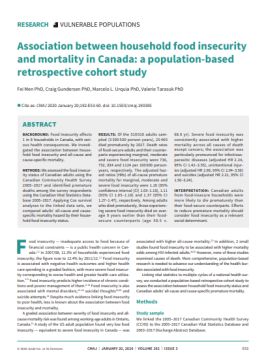Association between household food insecurity and mortality in Canada: A population-based retrospect
This resource is available in English only.
According to Toronto-based research project PROOF, income-based household food insecurity affects one in eight households across Canada, negatively impacting physical, mental and social health outcomes across the population. [1]
This journal article from Men, Gunderson, Urquia and Tarasuk presents Canadian data on food insecurity status correlated with rates of premature death in over 510,000 adults. The findings reinforce that income-based household food insecurity is a social determinant of mortality.
Food insecurity related to mortality
The data associates marginal, moderate, and severe food insecurity with higher rates of all-cause mortality for both men and women. Notable findings include that severe food insecurity was associated with higher mortality rates across all conditions (except cancer) and occurrence of death nine years earlier than adults who are food secure. As well, higher rates of death across all levels of food insecurity for avoidable conditions were noted.
Income-based food insecurity
The results also show that adults who have income-based food insecurity do not experience the same benefits from public health disease prevention efforts as those who are food secure. Results related to the relationship between food insecurity and higher rates of unintentional injuries and suicide points to the need for public health investigation and intervention in these areas.
Overall, this research reinforces the need for societal interventions that address material and social deprivation as the basis for risk from disease and mortality, and a necessary area of focus for public health action.
Use this resource to
- support the need for public health intervention on material and social deprivation to address food insecurity;
- describe the link between causes of premature death and levels of food insecurity in your community;
- Identify population groups experiencing food insecurity in your own area by using this article as a frame to analyze local data; and
- develop a strategy to address material and social deprivation to reduce population level morbidity and mortality risk.
Resource reference
Men, F., Gunderson, C., Urquia, M.L., Tarasuk, V. (2020). Association between household food insecurity and mortality in Canada: A population-based retrospective cohort study. CMAJ;192:E53-60
References
[1] PROOF. PROOF – Research to identify policy options to reduce food insecurity [Internet]. Toronto (ON): University of Toronto; 2017 [cited 2020 May 22]. Available from: http://proof.utoronto.ca/.
Related resources
- Learning from Practice: Advocacy for health equity - Food security (2017)
- Public Health Speaks: Upstream action on food insecurity (2017)
- Upstream action on food insecurity: A curated list (2017)
- Webinar recording: Taking action on the root cause: Inadequate income and food insecurity (2017)
- Youth action on food insecurity: A toolkit for secondary school students to use in clubs and other extracurricular activities (DRAFT) (2019)
- Implications of a basic income guarantee for household food insecurity (2017)
